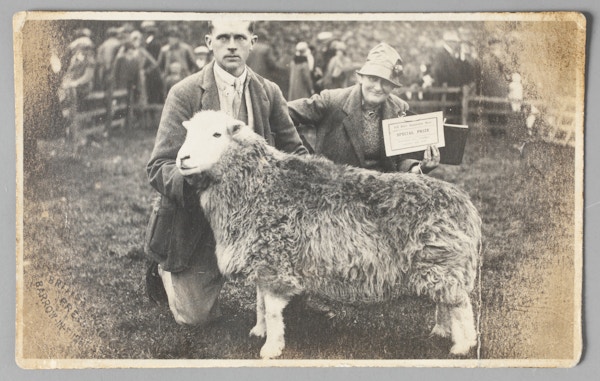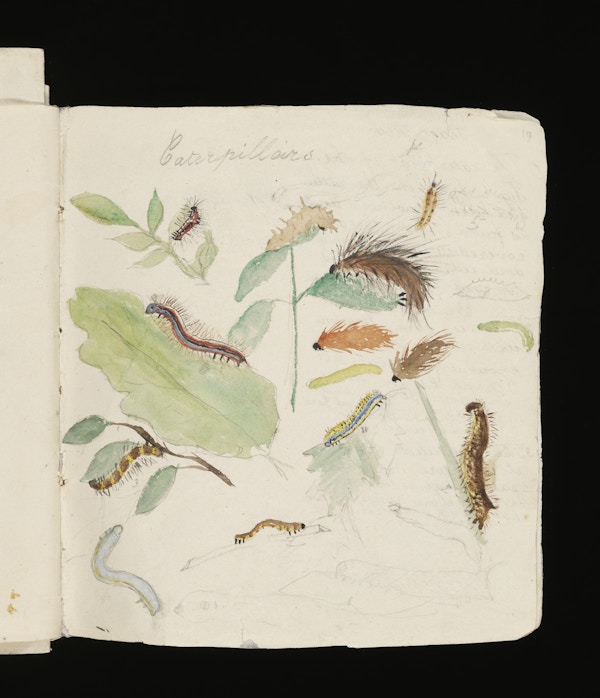
Tailor of Gloucester endpaper, December 1903. Watercolour, ink and pencil on paper. Linder Bequest. © Victoria and Albert Museum, London, courtesy Frederick Warne & Co Ltd.
The Victorian author had a lifelong passion for flora and fauna, observing them and drawing them wherever she went. As well as writing charming books for children, she was an expert in fungi, a prize-winner breeder of sheep and a prosperous farmer.

Tom Storey and Beatrix Heelis with prize-winning ewe , 26 September 1930. Photographic print, published by the British Photo Press. © National Trust
This rich and varied exhibition charts her life from a childhood in Edwardian upper-middle-class London, where she was educated by a governess, to an adulthood in bucolic Cumbria via a staggeringly successful literary career.

The Tale Of Jemima Puddle-Duck Artwork, 1908. Watercolour And Ink On Paper. © National Trust Images
The Times says: ‘This glorious exhibition, delayed by Covid, show’s Potter’s passion for nature, her artistic talent and how the two fed each other, from her childhood drawings, her 23 children’s book, including The Tale of Peter Rabbit, to her mission to preserve areas of the Lake District.’

Sketch for the privately printed edition of The Tale of Peter Rabbit, 1901. Pencil on paper. Linder Bequest. © Victoria and Albert Museum, London
When Beatrix died aged 77 on 22 December 1943, she left fourteen farms and more than 4,000 acres in the Lake District to the National Trust, who have collaborated with the V&A on the show.
Helen Antrobus, the National Trust’s Assistant National Curator for Cultural Landscapes, is the co-curator of the exhibition and says: ‘Beatrix was one of the greatest supporters the Trust has ever had, fervently believing that the landscapes from which she had drawn so much joy should be protected so that others could experience them.’
Here, we tell you why you and your children should go to the new Beatrix Potter show.
Drawing of a rabbit (Peter Piper) by Beatrix Potter. ca 1892. (c) Victoria and Albert Museum, London, courtesy Frederick Warne & Co Ltd.
ONE
Because Beatrix Potter: Drawn to Nature examines the writer’s life as a scientist and
conservationist and the places and animals that inspired her famous characters, it appeals to the whole family and not just to current Peter Rabbit fans.

The Mice at Work Threading the Needle, The Tailor of Gloucester artwork, 1902. Watercolour, ink and gouache on paper © Tate
The curators say: ‘We hope [the exhibition] will inspire the next generation of artists and storytellers, but also natural scientists, conservationists and farmers. Potter’s story shows that through talent, passion and perseverance, life can take unexpected twists and turns and great things can grow from inconsequential beginnings.’
TWO
Potter kept sketchbooks from the age of eight. Her drawings, many of which are on display here, are as enchanting as her stories. One, a magnified study of beetles, drawn in about 1887, is an arresting highlight.

Page from a sketchbook, c. 1875. Watercolour over pencil on paper. Linder Bequest (c) Victoria and Albert Museum, London
THREE
The exhibition is full of nuggets of information about Potter that are a delight to learn – such as: Her first name was really Helen. She kept more than 92 pets in her lifetime, among them a beloved border terrier. Growing up in London, she regularly visited the Royal Academy and the South Kensington Museum (which later became the V&A).
FOUR
Beatrix Potter: Drawn to Nature showcases over 240 personal objects, including rarely seen letters, manuscripts, coded diaries and family photographs. Also on show is an embroidered 18th-century waistcoat that Potter spotted on a visit to the South Kensington Museum and used as inspiration for the Mayor of Gloucester’s coat.

Mrs Rabbit pouring tea for Peter for The tale of Peter Rabbit by Beatrix Potter, 1902. © Victoria and Albert Museum, London, courtesy Frederick Warne & Co Ltd.
FIVE
Potter’s career really began with a couple of divine Christmas cards that she’d drawn, which are displayed here. The curators say: ‘We are delighted to be able to include an original design and two examples of Christmas cards printed from designs by Beatrix Potter, her first commercially sold illustrations.
‘The cards such are an important part of the story of Beatrix’s journey to becoming an author-illustrator and the success of the cards speaks to her practical mind and business acumen.’

Mrs. Tiggy-Winkle Artwork, November 1904 - July 1905. Watercolour And Ink On Paper. © National Trust Images
SIX
An excursion to the V&A is always an enriching experience for the family. The world’s leading museum of art and design needs our support now more than ever. and Tickets to Beatrix Potter, which will be on for the rest of the year, are free for members and otherwise cost £14 a head.
Book tickets to Beatrix Potter: Drawn to Nature at the V&A here.
By Becky Ladenburg
February 2022
Read More
6 Homes With Literary Connections
The Best of Berkshire
Step Inside Rembrandt’s The Night Watch


